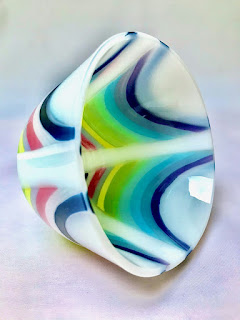When making a drop vase in opalescent glass, the design needs to be on the outside. This will require ensuring the design will be on the bottom when suspended on the drop ring.
It is possible to build the whole piece as normal with the design on the top and fire it. Then you can turn it over to make sure the design is facing downwards.
To get a crisper design for the outside the flip and fire technique can be used. Build from the outer layers to the inner layers. You are building upside down. Place the design to be seen on the outside of the drop vase down on the prepared shelf first. Follow this up by placing the inner layers in order from the most outside to the most inside layers.
These instructions rely upon firing the blank first rather than building on the drop ring.
However, you can build on the ring if you need to save one of the two long firings. Only one modification is required. Place a sheet of clear down first. Assemble the design as for a flip and fire technique, i.e., outside layers first, inside layer last.
This will require a slow heat up to ensure you have allowed enough time for the air to be squeezed from between all the layers and that all the glass at the same temperature before the drop begins. Sprinkling a fine layer of clear powder over the clear is a good way to assist allowing the air out. Place the design pieces down before applying the powder.
This is not the best way to make drop vases, but it can work with care in placing the decorative pieces and applying the powder.











